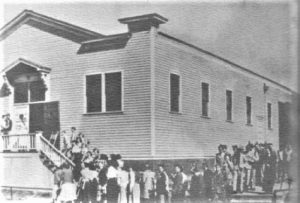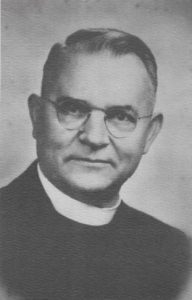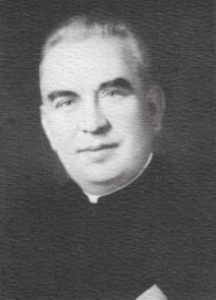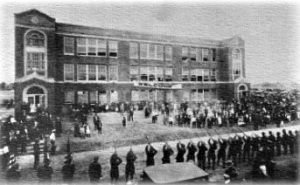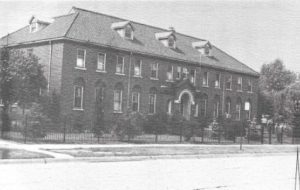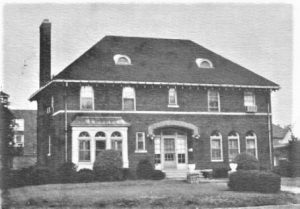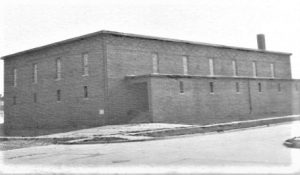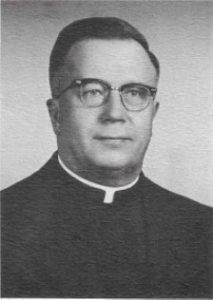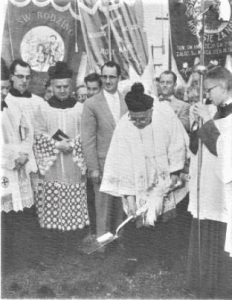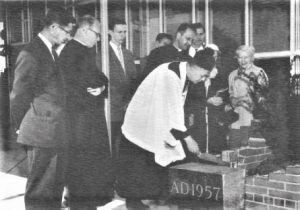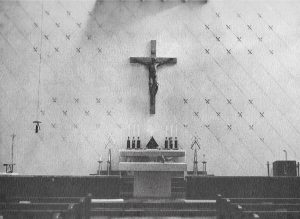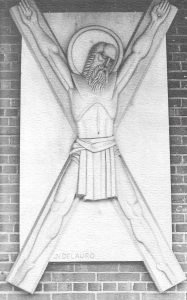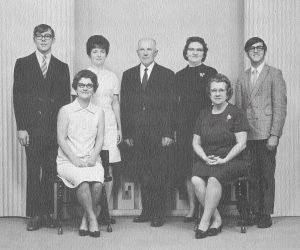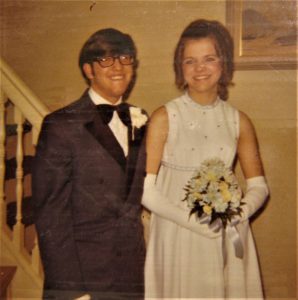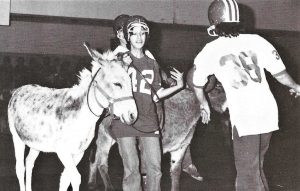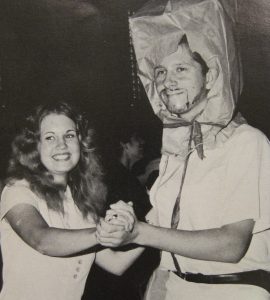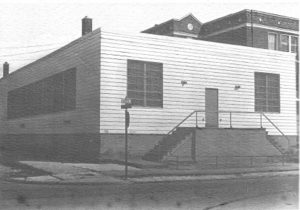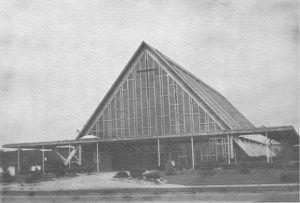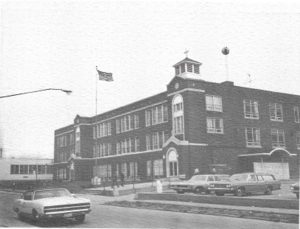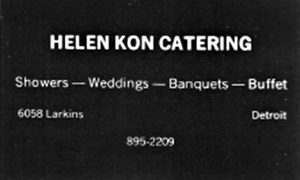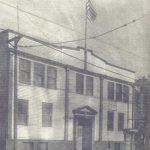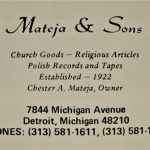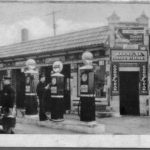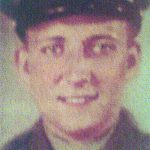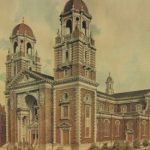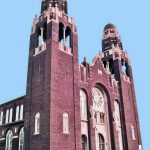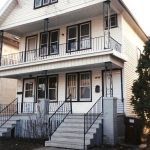A History of St. Andrew Church and School
7060 McGraw and 5690 Cecil, Detroit, Michigan 48210
St. Andrew Catholic Church at 7060 McGraw Street was founded in 1920 by a group of Catholics in the McGraw-Chopin area of Detroit’s west side, a predominantly Polish community. Polish immigrants were flooding into the large industrial and coal-mining cities of America at the time, and like numerous major cities across the country, Detroit was a rapidly growing industrial metropolis. Many of the immigrants came from southeastern Poland and settled on Detroit’s west side.
Detroit was home to several automobile plants where good-paying jobs could be found. Because of the auto manufacturing plants, there were a multitude of automotive component producers that had emerged in Detroit, including paint, glass, steel, and rubber manufacturing facilities. Detroit had great appeal for many Polish immigrants. The area around McGraw Street between Livernois and Lonyo became one of Detroit’s thriving Polish communities.
The group of Catholics formed a committee consisting of C. Dombrowski, chairman, and committee members M. Dombkowski, V. Wrona, W. Jeruzal, L. Staskowski, L. Jedynak, W. Pankowski, B. Unold, C. Latosiewicz, and W. Wypych. The committee members petitioned then-Bishop Michael J. Gallagher to approve the construction of a new church. Bishop Gallagher gave his approval, and on October 15, 1920, assigned Rev. Maximilian Gannas of Our Lady of Mt. Carmel Parish in Wyandotte to organize the new parish.
On November 26, 1920—Thanksgiving Day—Rev. Gannas purchased two lots of land at McGraw and Tarnow Streets, and plans for a temporary church were laid out. Bishop Gallagher approved the plans the next day, and on November 29, the vigil of St. Andrew—the church’s namesake—the committee met to consider construction bids.
Poles and other East Central Europeans have always revered St. Andrew, as it is believed that this saint was responsible for bringing the Christian faith to the Eastern European countries.
After groundbreaking, the simple frame church was constructed in a record 15-1/2 working days. It was 90 feet by 46 feet with a seating capacity of 550. Bishop Gallagher, along with 10 clergy from neighboring parishes, blessed the newly installed church bell on February 20, 1921. Rev. Gannas became the first pastor of St. Andrew. Bishop Gallagher blessed the church in time for midnight Mass to be celebrated there on Christmas Eve. Masses were also celebrated at 8:00 A.M. and at 10:30 A.M. on Christmas morning. The committee members told Bishop Gallagher that one day they would build one of the most beautiful churches in the city of Detroit.
On May 9, 1923, Rev. Stephen Trepczynski of St. Michael’s Parish in Port Austin became Rev. Gannas’ successor. Because there were so many young people in the parish, his first assignment was to oversee the construction of a new school on Cecil near McGraw. Under Rev. Gannas’ direction, a school was constructed with 24 teaching classrooms.
In 1926, the Felician Sisters arrived to teach the students. By then, the church and school were growing so rapidly that the school basement was used as a temporary church while construction of the rectory began. The new school was blessed by Bishop Gallagher on September 19, 1926, with the assistance of 25 priests and in the presence of a crowd of approximately 5,000. Bishop Gallagher and Rev. Joseph Lempka, Pastor of St. Stanislaus Parish in Detroit, spoke at the ceremonies.
At the start of the 1926 school year, 130 new families joined the church, and school enrollment climbed to 1,764. The faculty consisted of 14 sisters and six lay teachers. On March 17, ground was broken for the construction of the convent. On August 31, 1930, the convent was completed.
By 1940, there were 984 students enrolled in the elementary school, and the first high school class was formed. The first freshman enrollment at St. Andrew High School consisted of 48 students. Four years later, 21 students graduated from the high school. On June 19, 1944, the high school became accredited.
In 1945, Rev. Trepczynski petitioned then-Archbishop Edward F. Mooney for approval to build a new, much larger and more elaborate church. The plans called for a Romanesque-style church with a seating capacity of 1,000 at a cost of approximately $250,000. N. Kostrzanowski was the proposed architect. Rev. Trepczynski indicated that $220,000 had already been secured for the church’s construction. Although Archbishop Mooney immediately approved the petition, for various reasons, the plans did not come to fruition.
On November 30, 1948, Rev. Trepczynski requested approval to have a gymnasium built. In a letter dated July 7, 1949, Chancellor Monsignor Hickey approved the request, and in 1949, a “spacious activities building” was built “to serve the educational, social and athletic needs of the parish.” 1/
In 1944, there was no sports program at St. Andrew, but there was one at Chadsey High School, which was located roughly a block away at 5353 Martin Street. Chadsey had hundreds of students compared to the still-developing St. Andrew at 5690 Cecil. But as enrollment in St. Andrew High School grew, so did interest in sports, and athletics programs began to be established. Social activities also increased. Those programs and activities would grow substantially throughout the ensuing years.
The end of World War II saw thousands of soldiers pouring into American cities, including Detroit, as they returned from overseas. In Detroit’s Polish neighborhoods, the War’s end also resulted in a proliferation of P.L.A.V. and V.F.W. halls to accommodate the many social activities and celebrations that were taking place. Enrollment in the area’s churches increased and resulted in an upsurge in weddings, receptions, baptisms, christening parties, and anniversary celebrations, as well as dances and parties. Churches were thriving, and the need for activities centers and banquet halls soared. St. Andrew was no exception.
In 1951, new pews were installed in the church at a cost of $14,000, upon approval of a request submitted by Rev. Trepczynski.
The St. Andrew sports program in general was expanding during that time. West Side Detroit Polish American Historical Society member Lorraine Salata Kasper, a 1959 graduate of St. Andrew High School, grew up on Tarnow Street, just blocks from the church and school. Her entire family was involved with the parish and in the west side Polish neighborhood community. Lorraine also attended St. Andrew elementary school.
Lorraine recollected that it was exciting to support the St. Andrew basketball team and to follow the team’s activities during her school years, especially during the early 1950s. The 1951 and 1952 basketball teams were State Champions in Class C and Class B, respectively.
In 1956, the St. Andrew boys’ basketball team became the first Catholic team to beat a public school in the city basketball championship. The team went on to play in the state championship and earned the title of Class B State Runner-Up Champions. They played Stephenson High School at Jennison Field House on the Michigan State University campus in East Lansing. St. Andrew lost in an intense sudden death elimination in the third overtime, but Lorraine recalled that the excitement of the game was felt throughout the entire school.
After Rev. Trepczynski resigned on January 1, 1954, due to poor health, Rev. Francis A. Banaszak became pastor of St. Andrew. Rev. Banaszak had been pastor of Resurrection Parish in Detroit. A short time later, $12,400 was invested in remodeling the activities building.
On May 18, 1956, approval was granted for construction of a new church. Ground was broken and the existing, permanent church structure was built in 1956, following which the former basement church was converted to 10 modern classrooms. The new church was designed to inspire. The upswept pitch of the church’s roof “forms its own spire, lifting the eye upward to create an atmosphere of worship. There is no ‘fussiness’ for the entire chancel wall is a sheer expanse of eggshell-white stone spattered with gold. Its only ornamentation consists of a modern-style, lifesize crucifix and a canopy of zigzag pattern above the main altar.” 2/
The church’s architecture, both exterior and interior, incorporated X’s throughout. Even the door handles bore the “X” shape. Throughout history, St. Andrew has always been depicted bearing a cross in the shape of an “X.” He requested that he be crucified on that shape of cross as he felt unworthy to be crucified on a cross similar to the one on which Christ was crucified.
In 1959, remodeling began on the church’s annex, which was the original church building that was being used for grade school education when the new church was built. The renovation project created classrooms for art, home economics, and drafting.
An impressive drafting room was located in the front of the building and was designed in accordance with requirements of the Board of Education and the University of Michigan. The architect of the drafting room was Walter J. Rozycki, and the contractor was Matthew Lalewicz. Six rows of desks were constructed, which faced Larkins Street. Also included was a craft area that housed two large tables, cabinets for student use, and power and hand tools. Storage and planning areas were created in the rear of the classroom.
An art room that would accommodate 30 students was added, in keeping with an art program that was being introduced by the Archdiocese of Detroit in the fall of 1959. S. M. Aloysius, drafting and art instructor, coordinated the drafting and art room plans. Mrs. Isabelle Ducci was hired as the art supervisor.
A sewing room was also included in the renovation project. The room was equipped with 16 sewing machines and an instructor’s machine, all purchased from the Singer Company. Facing Cecil Street was a stage for fashion fittings and reviews. In addition to personal drawers, the sewing room was furnished with “wardrobe sections, full-length mirrors, and fitting rooms.” 3/
Dome lighting and new flooring rounded out the construction project, which was scheduled to be completed in June of 1959, in time for fall classes. Preference for classes, which were elective, was given to seniors and juniors.
Lorraine Kasper recalled how life at St. Andrew High School differed considerably from the grade school experience. The mid- to late-1950s was a time of tremendous growth in the west side Polish community, and St. Andrew was flourishing. Students arrived from various neighboring grade schools such as St. Cunegunda, St. Lawrence, St. Barbara, SS. Peter & Paul, St. Christopher, Assumption, St. Francis d’Assisi, Our Lady Queen of Angels, St. Stephen, and St. John Cantius and, according to Lorraine, they “all blended with our St. Andrew students.” 4/
In addition, not only were the students assigned Home Rooms, but they also attended classes on the third floor of the school, and for the first time they changed classrooms for various subjects and had different teachers. They were given the option of trying out for sports teams. Lorraine shared that she tried out for—and made—the girls’ basketball team and the Junior Varsity Cheerleading Squad which, at that time, were the only sports available for girls to participate in.
The late Thaddeus C. Radziłowski, Ph.D., co-founder (along with Ms. Virginia Skrzyniarz) of the Piast Institute in Hamtramck, shared his memories of the St. Andrew basketball team during the Society’s First Annual Pilgrimage & Święconka on April 5, 2008. Dr. Radziłowski recalled that when he was a high school student at Hamtramck High during the mid-1950s, St. Andrew was a rival basketball team. Many of the pilgrims at the event added that St. Andrew was known for its “superior, award-winning basketball team.” 5/
The teachers at St. Andrew were strict, but not overly so. The schedule was very disciplined. The elementary school students went to Mass at 9:30 A.M. every day. There was also a weekend children’s Mass at 9:15 A.M. on Sunday.
Rev. Lawrence Zurawski, a director on the board of the West Side Detroit Polish American Historical Society, recalled during an interview that the students were very involved in the Masses. They took part in the choir, serving, or reading. They rotated at planning the Mass. They read the scripture readings and planned a theme, around which the music was planned. They used burlap, felt, scissors, and Elmer’s glue to make banners depicting the theme.
Some of the classrooms had sayings on the corkboards that Fr. Larry still remembers to this day, such as, “Instruction may end in the classroom but learning ends only with life.” 6/
Rev. Gary Michalik, President of the West Side Detroit Polish American Historical Society, was a parishioner and a 1971 graduate of St. Andrew High School. His older brother Ron graduated from St. Andrew, and all his friends were going there, so he wanted to go there, too. The school was only four blocks away from the Michalik home, so Fr. Gary was able to walk to school.
During an interview, Fr. Gary also recalled the phrases that were on the classroom corkboards. They had plastic letters with pins inserted into them with which to put the phrases onto the corkboards. Sometimes the sisters would cut out the letters, and sometimes they would have designs on the ends of the phrases.
Fr. Gary remembered a particular Eucharist theme that was on the bulletin boards. It featured a chalice, artificial grapes, and wheat. He remembered that at the end of the year, the designs and phrases came down, and the bulletin boards were covered with newspaper to keep them clean throughout the summer.
Every classroom had an American flag in it, and at the end of the year the nuns rolled up the flags and covered them with newspaper or brown paper.
The students were required to have book covers on their books. Sometimes local businesses would provide them. Other times, the students were supposed to bring brown paper bags to school, and there was a specific way to cut and fold the bag to enable it to fit over the cover and inside the front and back covers of the book to protect it. All the books were numbered, and the students had to return them at the end of the year. Writing in the books was prohibited.
Students were also asked to help wax and polish their classroom floors by bringing in empty Silvercup bread bags. As the students sat at their desks, they placed the empty bread wrappers underneath their feet and shuffled their feet. It was a rather ingenious way to keep the floors polished while disciplining the students. Lorraine Kasper recalled doing this in the 1950s. Fr. Gary stated that the students were still doing it during his sophomore year with Sr. Erminelda, commenting that it was somewhat humorous to see the kids shuffling around with waxed paper on their feet during tenth grade high school.
In addition to learning reading, writing, and arithmetic, grade school students were also taught religious education. They studied from the Baltimore Catechism, memorizing numerous prayers and learning various religious songs. In the third grade, they prepared for First Penance and Communion and prepared for Confirmation in the sixth grade by attending many novenas, devotions, and religious processions.
The Polish influence was very evident at St. Andrew. Polish language was taught at St. Andrew Grade School through the use of flashcards. The students learned Polish prayers, songs, and grammar. Fr. Larry commented on the unique aspect of St. Andrew yearbooks, stating that almost every name in the books was Polish.
In the 1950s, not only were general education classes taught in the high school, but the Catholic faith was also taught, including Church history, doctrine, and beliefs. Freshmen learned Latin and Algebra. Sophomores took Bookkeeping and Biology in the third floor lab. Juniors were offered Typing and Journalism and could try out for the Glee Club. Seniors at the time were taught Economics, U.S. History/Government, and Religion, with priests teaching some of the Religion classes. The high school newspaper was the Andrite, and Journalism students could be reporters or editors for the paper.
The high school students attended Mass two to three days a week, sometimes in the morning before school. There were also May and October processions, devotions, and Stations of the Cross. The students were members of various religious societies.
In 1959, the rules for school attire changed. Girls were required to wear full or pleated skirts and plain blouses with cardigan sweaters or a blazer. Boys were required to wear a collared shirt and a tie.
Playing basketball and attending basketball games, cheerleading, going to dances, decorating floats and decorating the gym for dances and hops, and reporting for the school paper—in addition to events surrounding the various religious societies—were activities that made the school year whiz by for St. Andrew High School students.
Sr. Mary Edith, a very young teacher compared to the other sisters, was Fr. Gary’s ninth grade Home Room and Religion teacher during freshman year. In the fall of 1967, she had the students reading the Documents of Second Vatican Council—very difficult reading—to prepare them for the upcoming changes in the Church.
Sr. Mary Edith also taught Biology, but it was a course offered only to juniors. The only foreign language that was offered was Latin. Fr. Gary took one year of Latin, in addition to English, Writing, Literature, Math, and some sciences. There were the required courses, plus the electives.
During sophomore year, the only elective available was Typing. It was taught by Sr. Erminelda. Fr. Gary didn’t want to take it, but every time he sits down at his computer today, he’s glad that he did.
Social Sciences included History (American and World), Bookkeeping, and Sociology.
The librarian for some time was Sr. Hospicia. During library period, students caught up on homework or reading in the library. Fr. Gary shared that while in the library, students amused themselves by sneezing Sr. Hospicia’s name.
During the late 1960s and early 1970s, high school students attended Mass once a week in the morning.
Fr. Larry recalled that his curriculum in the 1970s was a typical one. Most of the students took Spanish, but he took French. There were about eight students in his French class. The high school offered a college prep program, in addition to another program. St. Andrew was good preparation for college.
In the 1960s, the automobile companies in Detroit were thriving. The city of Detroit was experiencing a period of growth. St. Andrew, too, was growing. Many church social activities were being added to St. Andrew’s calendar throughout the 1950s, 1960s, and 1970s. During those years, the church held an annual summer festival. The festival was held in the gymnasium until the mid-1970s. Anna Stark was a long-time chair of the festival, and Tillie Cybulski served as co-chair for many years. Numerous interactive games lined the perimeter of the gymnasium, and booths were set up in the center of the gym that held stuffed animals, canned goods, and craft goods. There was also a ham and bacon booth and a bunco game booth. Bunco was a very popular dice game played by groups of players.
By the mid-1970s, the festival had become so big that it was held not only inside the gym, but also outside. Rides and additional booths were added. The Parent-Teacher Guild had many fundraisers for the school. Fr. Gary recalled going to a Hawaiian dance and a Country and Western dance during the mid-1970s.
According to Fr. Gary, some of the societies involved with the festival were the Rosary Society, the Altar Society, the choir, the Usher Society, the Mothers Guild, and the Parent-Teacher Guild.
In addition, each year, when the City of Detroit held its Riverfront Ethnic Festival, St. Andrew set up a kiełbasa/kapusta sandwich booth at the festival.
Bingo was held twice a week. The Wednesday evening bingo was the parish bingo, with proceeds going to the general fund. There was also a Saturday bingo, which benefited the Athletic Department. The bingo games were on two levels, and an announcer used a “PA” (public address) system for communication throughout the games.
Fr. Gary worked at both the Wednesday and Saturday bingo games. Back then, smoking was allowed at the games, and anyone attending the games reeked of cigarette smoke when they got home.
There were also special fundraiser events. St. Andrew held seasonal bingos for Thanksgiving, at which the grand prize was a turkey. Dances were seasonal as well and included a Sadie Hawkins dance, homecoming, and prom.
Fr. Gary lived at home during his college years, and he commuted to the University of Detroit for classes. His parents, Joseph and Stella Michalik, were very involved in the parish, so he became even more involved when he went on to college. He worked at all the festivals and bingos.
Keno’s on Tarnow and McGraw was the parish bar in the 1970s. Everyone went there for drinks after bingo before they went home. It was customary in Polish neighborhoods during the era for parishes to have what was known as their own bars, just as they had their own funeral homes. Our Lady Queen of Angels had Stempien’s Bar, and St. Stephen had Michno’s Bar.
The funeral home for St. Andrew was Cylkowski, located directly across the street from the school at 5659 Cecil. They also used Jarzembowski, located originally at 4405 Wesson (later at 18957 West Warren Avenue), and Sajewski, located at 19111 West Warren Avenue.
The late 1960s and early 1970s brought change and some difficult times. The 1967 Detroit riots took place during that period. Fr. Gary referred to the riots, which took place during the summer between his eighth and ninth grades, as “something to live through.” 7/ Fr. Gary remembered that St. Casimir High School closed in 1969, and a group of about eight students from St. Casimir transferred to St. Andrew at that time. Among them was a student named Marvin Webb, who was the first African American student to graduate from St. Andrew High School. He graduated in 1971.
During that time, life at St. Andrew High was almost the direct opposite of what it was in some suburban public schools, as there was no problem with drugs or alcohol at the school—although Boone’s Farm Wine was quite popular, and there was some cigarette smoking in the bathrooms, according to Fr. Gary. By contrast, in some suburban public high schools at the time, drug and alcohol abuse by students had become a big problem.
St. Andrew students were dismissed at a different time than the students at the neighboring Chadsey High School in order to prevent the students from mingling with one another.
On March 15, 1970, Rev. Banaszak resigned. The following June, Rev. Francis P. Kozlowski of St. Paschal Parish in Taylor was appointed Pastor of St. Andrew. Fr. Kozlowski was a big man who smoked a cigar. He looked rough and tough, but deep down he was as tender as a pussycat, according to Fr. Gary. His nickname was Fuzzy because when he was young, he had really curly hair. Of course, the students never called him by name, but rather, “Fr. Pastor.” Fr. Larry recalled that Fr. Kozlowski called the students “my little darlings,” no matter how old they were.
In the 1960s and 1970s, the entire west side Detroit-area Polish community enjoyed a time of steady activity. Fr. Larry recalled that polka bands performed every Sunday in the basement lounge during the 1970s at the Holy Cross Council #2739 Knights of Columbus hall at 4381 Larkins at Michigan Avenue, and the parties drew many parishioners and students from St. Andrew.
Although the sports program was still thriving at St. Andrew during the 1960s and 1970s, from 1967 through 1971, the football team never won a game, according to Fr. Gary, and during an interview, he stated that he didn’t believe that the basketball team won a game either during that time. However, a couple of years later, the sports program improved significantly. Bob Shoemaker became the coach, and he turned the entire sports program around.
By the time Fr. Larry, a 1976 graduate, arrived at St. Andrew, the school had the number one basketball team in the area. The basketball team was one of the reasons Fr. Larry was attracted to St. Andrew, as he enjoyed attending basketball games. The Felician Sisters, the school’s Polish influence, the small size of the school, and the close-knit nature of the student body were all appealing features to Fr. Larry. It took two buses and a significant walk for him to get to St. Andrew from his St. Christopher neighborhood, but he considered the long trip well worth it.
During that time, famous sports figures went to the school to sign autographs and to give presentations to the students. Also during that time, the Athletic Department featured Big Time Wrestling in the gym, as well as donkey basketball—a novelty—played for fundraising events. During donkey basketball games, players rode on donkeys while shooting hoops. Presumably the donkeys came from farms in the surrounding communities.
There was no cafeteria at St. Andrew, so the students ate in classrooms. At lunchtime, they could buy milk and Better Made or Superior potato chips, as well as candy, but they had to bring their own sandwiches from home. The milk, chips, and candy were sold by the school on the third floor, and student volunteers helped with the sales.
Fr. Larry recalled that St. Andrew was like a family because everyone knew each other. They had a connection with local businesses such as Stan’s and the Senate Coney Island. The businesses hired students to work part-time. Guzik’s party store was right across the street. At lunch time, the employees bartered with the high school students who went to the store to buy pop and candy.
When Fr. Larry was in his junior year at St. Andrew, his class started a hot pretzel sale, which was a big success.
Fr. Larry recalled that Ring Day was a big event at St. Andrew. That was the day on which students received their class rings, and it was considered a milestone occasion. The students usually received new outfits for the occasion. They attended Mass, and their class rings were presented to them. There was a meal afterwards in the parish hall, which was in the gym basement. The meal was prepared in the kitchen by Mrs. Buda or Mrs. Kon, two local caterers.
During the mid-1970s, there were many school dances at the high school, and often the Polkadelics was the performing band. It was a band made up of students from St. Andrew.
The 1980s ushered in a new era in the life of the parish and the school. By that time, Fr. Gary had been ordained a deacon. He had enrolled in the St. John Provincial Seminary in Plymouth following graduation from the University of Detroit and was ordained to the diaconate in December of 1979. On June 1, 1980, he was ordained to the priesthood, and on June 22, 1980, he returned to his roots and celebrated his first Mass at St. Andrew Church.
During the 1980 – 1981 school year, enrollment in St. Andrew’s elementary school totaled 237. High school enrollment totaled 363. Sr. M. Margaret was the elementary school principal, accompanied by five religious and six lay teachers. Sr. Kathleen was the high school principal and was assisted by six religious and 16 lay teachers.
The neighborhood was changing, and like many Catholic schools in the area, St. Andrew School closed in June of 1987. But the impact that the Felician Sisters had on the students of St. Andrew cannot be measured.
Twenty Felician principals served at the school throughout the years: Sr. M. Honorina, Sr. M. Maura, Sr. M. Tarcilia, Sr. M. Alexandrine, Sr. M. Edmunda, Sr. M. Fabiola, Sr. M. Bonfilia, Sr. M. Electa, Sr. M. Benedicta, Sr. M. Paula, Sr. M. Dominic, Sr. M. Assumpta, Sr. M. Prudence, Sr. M. Marcianne, Sr. M. Bernadette, Sr. M. Cynthia, Sr. M. Dolores Ann, Sr. Angela Maria, Sr. Kathleen, and Sr. M. Margaret.
Pastoral Shepherds of St. Andrew were Rev. Maximilian Gannas (1920 – 1923), Rev. Stephen Trepczynski (1923 – 1954), Rev. Francis A. Banaszak (1954 – 1970), Rev. Francis P. Kozlowski (1970 – 1981), Rev. Michael S. Filip (1981 – 1983), Rev. Thomas Puzio (1983 – 1987), and Rev. Julian Chmura (1987 – 2008).
Societies that existed at St. Andrew were St. Andrew Society #2388 P.N.A., St. Vincent de Paul, Sacred Heart, St. Francis – P.R.C.U., Retirees Club, Dads’ Club, Ushers’ Club, Holy Name, Holy Family, Altar, Rosary, Mothers’ Guild, Third Order of St. Francis, Apostleship of Prayer to the Sacred Heart, St. Salomea No. 1368 Z.P.R.K., Polish Women’s Alliance – Group 386, Parents’ Club, St. Andrew’s Choir, Legion of Mary, Parent-Teachers Guild, and St. Andrew’s Choir. The Parish Council was formed in 1970 and replaced the St. Andrew United Parish Society. It consisted of the pastor, associate pastor, two religious, and 15 lay people and was entrusted with making major decisions on behalf of the church.
The final Mass was celebrated at St. Andrew on August 31, 2008, with approximately 800 in attendance. At the time of the church’s closing, Masses were still being said in both Polish and English. Bishop Daniel E. Flores was among the final Mass celebrants. Fr. Gary served as Master of Ceremonies. In his homily, Bishop Flores said that the founders of St. Andrew Parish built the church thinking of their grandchildren, in the hopes that the faith would take root in their hearts.
At the end of the Mass, there was a sad procession in which the statue of St. Andrew was carried out of the church. There were many tributes presented, including a framed memorial given to the parishioners and St. Andrew’s last pastor, Rev. Julian Chmura, by the West Side Detroit Polish American Historical Society. At the time of its closure, there were plans for the church to be used as a chapel.
St. Andrew Church and School and the surrounding neighborhood are examples of a community that worked together in harmony. People in the parish neighborhood lived in their homes throughout their entire lives and walked to and from church. They were highly involved in parish life.
It was not unusual for all the children of a family to attend both grade school and high school at St. Andrew, reflective of the faith that took root and grew within and among families for generations, as described by Bishop Flores in his homily at the closing Mass. Lorraine Kasper’s parents moved into their home on Tarnow Street in 1923. Lorraine, her four sisters, and three brothers all attended St. Andrew Grade School. Three of them, including Lorraine, attended St. Andrew High School. The others attended the Felician Academy and Chadsey High, only because St. Andrew High School was not yet established when they had reached high school age.
Sixteen of Lorraine’s family members attended St. Andrew schools between 1926 and 1978. Several Salata family members were also married at St. Andrew: Gertrude Salata Kubik, Adele Salata Tabaka, Jane Salata Donakowski, Mary Salata Rokita, and Edward Salata in the old church, and Lorraine Salata Kasper and Cynthia Salata Forman in the new church.
Today, virtually everyone who reminisces about St. Andrew recalls the close-knit aspect of the parish family. Lorraine Kasper wrote that everyone saw each other “at Masses, devotions, processions, and other church events. We were neighbors, parishioners, and classmates. We interacted almost every day. We knew almost everyone in our parish.” 8/
There was tremendous discipline at St. Andrew Grade and High School. The students were taught to respect their instructors and pastors, as well as school and church property, and to revere the faith.
The nuns at St. Andrew brought out the best in the students. They inspired and guided the students, encouraging them to fulfill their goals. Some of the nuns in the 1950s who left a lasting impression on the students were Sr. Donuella, who taught kindergarten; Sr. Theodosia, who taught third grade; and Sr. Benecia [phonetic], who taught sixth grade.
Sr. Nazarita, a young nun, taught Latin and Journalism at that time. Sr. Aloysius was an artist who greatly inspired her students, especially with her talent for making signs and trimmings and decorating floats for homecoming. Sr. Huberta was musically gifted and brought out the students’ musical talents at plays, assemblies, and church functions. Sr. Rachel personally inspired Lorraine Kasper to apply for college and to pursue a career in teaching physical education.
Fr. Larry Zurawski’s high school graduation class of May of 1976 was the smallest class in the school at the time. He recalled that the students got to see the different personalities of all the sisters, stating that one might think that nuns are serious all the time, but on the contrary, some of the sisters—in particular Sr. Laudine—liked to have a good time. Fr. Gary Michalik, who graduated in 1971, remembered Sr. Laudine as a wonderful person.
Fr. Gary did custodial work in the parish, along with his classmate, Tom Dombrowski. Every year for Christmas, the pastor gave the nuns a gift. Fr. Gary recalled a time around Christmas when Tom Dombrowski dressed up as Santa Claus, and Fr. Gary dressed up as Mrs. Claus. He was given the nickname of Claudine. When he and Tom went to the convent, Sr. Laudine couldn’t believe it when she finally realized who he was.
Fr. Larry recalled that all the teachers at St. Andrew were good instructors, but he particularly liked Sr. Martinez. He learned a lot from her in English and in French. Sr. Cynthia was the principal at the time and later head of the Livonia Province, and then eventually was elected to serve as the minister general of the Felician Congregation, where she was head of all the Felicians throughout the world.
Fr. Larry said that the students were close, not only in school but also outside of school. Following high school, Fr. Larry returned to St. Andrew a few times, but not very often. He attended college at Orchard Lake St. Mary’s, and his pastor at St. Christopher wanted him to serve at that church.
In 1985, he graduated from Josephinum Seminary in Columbus, Ohio. He was ordained a deacon and served six months as a deacon and six months as a priest. His ordination was in December. He was assigned to serve as deacon at St. Sylvester in Warren, where for the first time, he had an air-conditioned room. A couple of years ago, his parish, St. Thomas the Apostle in Garden City, held its annual parish festival, and some of his classmates from St. Andrew showed up.
St. Andrew High School also graduated some prominent people. Bishop Francis Reiss was a graduate, as was Msgr. Stanley Milewski. Several other priests graduated from St. Andrew. Fr. Larry stated that he believed that most of the graduates were successful in their chosen fields.
Two of Fr. Gary’s high school teachers are still living as of 2023: Sr. Presentine, who just turned 100, and Sr. Nancy—in addition to Society member Lorraine McFee, who was his kindergarten teacher. Lorraine is a 1958 graduate of St. Andrew High School, and she has organized the St. Andrew Multi-Class Reunions for the past several years.
At the reunions, which are held at west side Detroit-area banquet halls, it’s typical for graduates from classes spanning 30 years to attend and for there to be over 175 in attendance. Alumni from as far away as Arizona, Florida, and Nebraska have attended recent reunions, where milestone anniversaries are recognized and memories of St. Andrew are shared. Fr. Gary and Fr. Larry are frequent attendees.
In the past, the West Side Detroit Polish American Historical Society hosted two pilgrimages to St. Andrew Church. The first was on April 5, 2008, which was the Society’s First Annual Pilgrimage & Święconka. The second was on April 11, 2015, which was the Society’s Eighth Annual Pilgrimage & Święconka. In addition, the Society honored the organists who served at St. Andrew (as well as at other west side Detroit Polish churches) at the Society’s Third Annual Opłatek on December 29, 2008, and at the Fifth Annual Opłatek on December 29, 2010.
On November 28, 2010, the Society celebrated St. Andrew’s 90th anniversary with a Mass and reception at SS. Peter and Paul Catholic Church in Warrendale. The Mass was concelebrated by Rev. Jerry Pilus, Pastor of SS. Peter and Paul, and Msgr. Stanley Milewski, then-Chancellor Emeritus of the Orchard Lake Schools. Following the closure of St. Andrew, many parishioners went on to worship at SS. Peter and Paul. The statue of St. Andrew that was removed from the church during the closing Mass found a new home beside the altar at SS. Peter and Paul.
After St. Andrew Church closed, the buildings were used largely by community organizations. As of 2023, a non-profit organization owns the gymnasium, school building, and convent. The Detroit Police Athletic League utilizes the gym for youth events. In June of 2021, it was determined that for environmental and safety reasons, the church had to be demolished. A wrecking company began demolition at the beginning of June, and by the end of the month the project was nearly completed.
On June 1, 2021, Fr. Gary visited the demolition site and was able to acquire the church’s cornerstone contents for the West Side Detroit Polish American Historical Society’s archives. Society member Steve Isaacson procured a brick from the church, which he donated to the Society.
Although the church building is gone, and although the school has long since closed, St. Andrew lives on in the hearts and memories of all those who passed through its doors throughout the decades. When asked to recall their most cherished memories of St. Andrew, the majority of alumni responded with the same answers. It was the camaraderie of the students, the religious education, serving at Mass and as altar boys, the unity among the students, the nuns, and the discipline that they treasured most. Most of the former students also recalled the exceptional St. Andrew sports teams and the various sports that they participated in.
Homecoming and homecoming parades, bonfires on Friday nights before the football games, “freshman Friday,” the fall festival, and the relationship between the younger students and their upperclassmen were predominant memories. Younger students admired and respected the upperclassmen, who in turn looked after them.
One vivid and colorful memory was shared by Kathleen Hutt Urban, class of 1966. “I loved St. Andrew’s. It was the center of our lives. Church, Mass, school, festivals, basketball games, football games, dances. We were there! What I fondly remember is walking to Mass on Sunday mornings. I would walk down Martin and people would come out of their homes and make the walk toward 9 AM Mass. It was a pleasant sight to see groups of people all coming together and walking toward the same destination.”
Rosemary McCormick, who didn’t list her graduation year, shared a unique memory of swimming on the St. Andrew girls’ swim team. She wrote that there were three or four girls who swam at “Kronks” pool who decided to swim for St. Andrew. She wrote, “We swam for one year only against Visitation and other Catholic schools. We had no coach.”
Another anonymous alum wrote that his favorite memory of St. Andrew was “meeting all my friends . . . . Best of all I met my wife . . . my high school sweetheart.”
- “St. Andrew’s Parish History.” In Golden Jubilee (Złoty Jubileusz) Brochure – St. Andrew’s Parish – Detroit, Michigan: 1920 – 1970
- Ibid.
- “Remodeled Extension To House Drafting, Art And Sewing Classes.” In the Andrite. (Detroit: February 1959: Vol. 1: No. 3, Front Page)
- Kasper, Lorraine. Typewritten narrative to the author. (Tarpon Springs, FL: September 25, 2022)
- Gomulka, Laurie A. “First Annual Pilgrimage & Święconka: April 5, 2008.” https://www.detroitpolonia.org/first-annual-pilgrimage-swieconka-april-5-2008/
- Michalik, Rev. Gary, and Zurawski, Rev. Lawrence. Interview with the author. (Livonia, MI: September 27, 2022)
- Ibid.
- Kasper, Lorraine. Typewritten narrative to the author. (Tarpon Springs, FL: September 25, 2022)
Sources:
- Gomulka, Laurie A. “Demolition of St. Andrew Catholic Church: 7060 McGraw, Detroit 48210,” June 2021. https://www.detroitpolonia.org/demolition-of-historic-st-andrew-catholic-church/
- Gomulka, Laurie A. “First Annual Pilgrimage & Święconka: April 5, 2008.” https://www.detroitpolonia.org/first-annual-pilgrimage-swieconka-april-5-2008/
- Kasper, Lorraine. Typewritten narrative to the author. (Tarpon Springs, FL: September 25, 2022)
- Michalik, Rev. Gary, and Zurawski, Rev. Lawrence. Interview with the author. (Livonia, MI: September 27, 2022)
- “Our Parish History.” In Saint Andrew’s Parish 60th Anniversary Souvenir Pictorial Directory: 1920 – 1980
- Pakula, Anthony (“Tony”). Interview with the author. (Livonia, MI: September 26, 2014)
- “Remodeled Extension To House Drafting, Art And Sewing Classes.” In the Andrite. (Detroit: February 1959: Vol. 1: No. 3, Front Page)
- “St. Andrew’s Parish History.” In Golden Jubilee (Złoty Jubileusz) Brochure – St. Andrew’s Parish – Detroit, Michigan: 1920 – 1970
